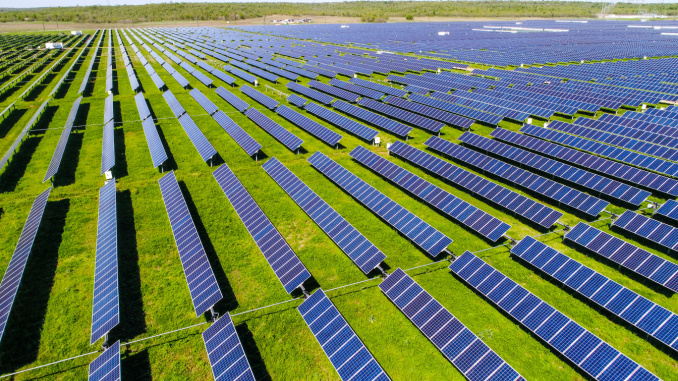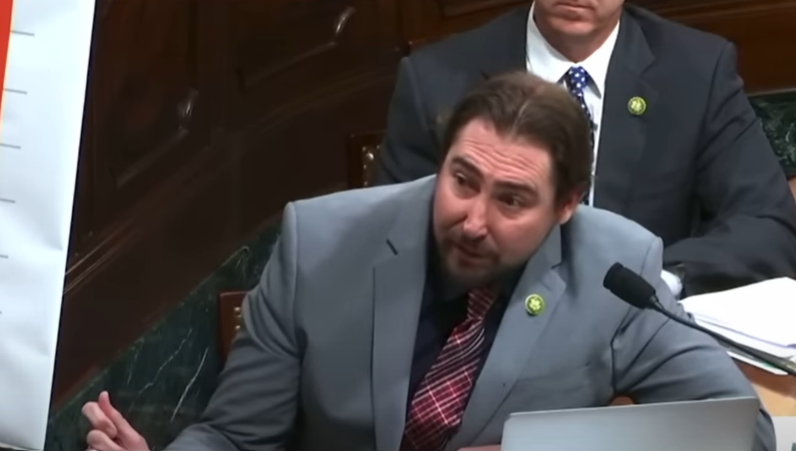
by AZ Free Enterprise Club | Oct 31, 2025 | Opinion
By the Arizona Free Enterprise Club |
The Green New Scam got its start in Arizona two decades ago when a 5-0 Republican Commission (including then Republican Kris Mayes) adopted the Renewable Energy Standard and Tarriff Rules, or the REST Rules. Among other things, most significantly it ushered in the first “renewable” mandates in our state, forcing utilities to obtain at least 15% of their power from “renewables.” Ratepayers have been paying the costs (over $2 billion) ever since.
The REST Rules had a target date: 2025. Well, it’s now 2025, and the utilities have not only met that mandate, but they have also voluntarily exceeded it. Now our current 5-0 Republican Commission has started the process of repealing them.
Repealing the REST Rules is important, but the targets have already been met, and the price has already been paid. Substantively, the repeal won’t really affect ratepayers all that much. Why? Because mandate or no mandate, our utilities are completely committed to going “Net Zero” by 2050, and so far, they’ve been allowed to do it…
>>> CONTINUE READING >>>

by Ethan Faverino | Oct 31, 2025 | Education, News
By Ethan Faverino |
Arizona Superintendent of Public Instruction Tom Horne issued a statement opposing the State Board of Education’s decision to postpone the rulemaking to strip Diversity, Equity, and Inclusion (DEI) language from Arizona’s teaching standards.
The issue will now be taken up at the Board’s December meeting—a delay Horne warns risks $866 million in federal education funding and violates clear federal civil rights directives.
“I respectfully but strongly disagree with the vote to postpone opening the rule-making process,” declared Horne. “The President issued an Executive Order requiring DEI language to be removed from programs funded by federal dollars. It made it abundantly clear that federal education funding is at risk if DEI language remains in education programs. Failure to comply with federal guidance may result in the loss of an estimated $866 million to Arizona schools. That is a major funding cut to our schools, and we need to begin dealing with this as soon as possible.”
Horne pointed to a letter from the U.S. Department of Education’s Office for Civil Rights (OCR), signed by Acting Assistant Secretary Craig Trainor, which reaffirms that discrimination based on race, color, or national origin is illegal under Title VI of the Civil Rights Act of 1964, the Equal Protection Clause, and controlling Supreme Court precedent.
The guidance explicitly condemns race-based preferences in admissions, financial aid, hiring, training, discipline, housing, and graduation ceremonies, and warns that DEI programs often “preference certain racial groups and teach students that certain racial groups bear unique moral burdens that others do not.”
The OCR letter also cites the Supreme Court’s 2023 ruling in Students for Fair Admissions v. Harvard (SFFA), which states that the use of racial preferences in school testing and admissions is unlawful. Their message is simple: “If an educational institution treats a person of one race differently than it treats another person because of that person’s race, the educational institution violates the law.”
“Not only is the $866 million at risk, but there is a philosophical issue at stake, too,” continued Horne. “All people should be judged based on their character and ability, not their race or ethnicity. DEI language and programs promote the exact opposite, and they have no place in the classroom. The teaching standards, unfortunately, include DEI references, and they need to be removed.”
The teaching standards at issue direct educators to teach “equitably,” with “responsiveness to the cultural backgrounds and differing perspectives learners bring to the learning environment,” and to address the “social, emotional, and cultural needs of students.”
“These terms do not belong in teaching standards,” Horne concluded. “The standards are meant to direct educators on the most effective ways to teach students’ core academics. Every instructional minute is precious, and DEI efforts distract from that essential mission.”
Ethan Faverino is a reporter for AZ Free News. You can send him news tips using this link.

by Jonathan Eberle | Oct 31, 2025 | Must Read, News
By Jonathan Eberle |
The Arizona Freedom Caucus announced that Representative Alexander Kolodin will lead a special hearing on “The Implications of Artificial Intelligence for Democratic Governance and How to Preserve Meaningful Elections” on Friday, November 14, 2025, at 9:30 a.m. in House Hearing Room 4 at the Arizona State Capitol.
The hearing, open to the public and livestreamed through the Arizona Legislature’s website, will focus on how the rapid development of artificial intelligence (AI) is reshaping democratic institutions and the electoral process. Lawmakers plan to explore both the opportunities AI presents for improving government efficiency and the potential threats it poses to election security, voter confidence, and public trust.
Representative Kolodin, who chairs the House Ad Hoc Committee on Election Integrity and Florida-style Voting Systems, will be joined by four other Arizona House members, including fellow Freedom Caucus member Representative Rachel Keshel.
“The states cannot be complacent when it comes to the rapid development of AI,” Kolodin said in a statement. “The risk of insufficient oversight of AI is literally what dystopian nightmares are made of. Although it is reasonable to be excited about the prospects of AI to improve human life and society, it is equally critical to be vigilant about the ways it can be abused to erode our freedoms, including threatening democratic governance and our elections.”
The Arizona Freedom Caucus said it views the hearing as a proactive step toward crafting policy that anticipates how AI could be weaponized to undermine democratic processes. The group emphasized that while AI offers enormous benefits, its misuse could have far-reaching consequences for liberty, privacy, and electoral integrity.
“There is perhaps no greater concern than how AI will impact our elections,” the caucus said in its release. “We believe the best way to prevent destructive scenarios is to address AI’s prospective impacts and uses on the frontend.”
The November 14 session is expected to feature expert testimony and legislative discussion on strategies to safeguard Arizona’s electoral systems while responsibly integrating emerging technologies.
Members of the public can view the livestream of the hearing here.
Jonathan Eberle is a reporter for AZ Free News. You can send him news tips using this link.

by Matthew Holloway | Oct 31, 2025 | News
By Matthew Holloway |
U.S. Congressman Eli Crane (R-AZ02) announced his election as Chair of the Congressional Justice for Warriors Caucus (CJWC) this week.
Crane is a Green Beret veteran with multiple combat deployments in Afghanistan and Africa. The CJWC, established in 2019, focuses on addressing injustices faced by service members and veterans, including wrongful convictions, flawed military investigations, and nonjudicial punishments.
The caucus has secured clemency, parole, and pardons for affected individuals, while advocating for improved medical care, correction of records, and accountability from the Department of Defense and Department of Veterans Affairs for unmet congressional mandates.
The group also works to reform aspects of military law, such as the Uniform Code of Military Justice and Rules for Courts-Martial, to protect against unlawful command influence, prosecutorial misconduct, and misapplication of rules.
“I’m honored to serve as Chairman of the Congressional Justice for Warriors Caucus, which does vital work on behalf of our military community,” Crane said in a statement. “I encourage any veteran who believes they’ve been wrongfully persecuted to reach out. We’re here to help.”
Posting the announcement to X, Crane wrote, “This Congress, I’m honored to chair the Congressional Justice for Warriors Caucus. Since 2019, the Caucus has delivered positive outcomes for our military community. If you are a veteran who believes you have been wrongfully persecuted, please reach out.”
Crane will be joined by Rep. Daniel Webster (R-FL) as Executive Member, along with Reps. Eric Burlison (R-MO) and Cory Mills (R-FL). Veterans or those with relevant cases can submit information through the caucus website.
The caucus advised that for veterans to streamline their inquiries, they should be prepared to provide:
- VA claim number for a case with the Department of Veterans Affairs;
- Charge sheet from either DOW or civilian court that you are seeking assistance with;
- A timeline of events in chronological order;
- Any pertinent and concise letters of support from witnesses of the event;
- Both the government’s and the defense’s appellant briefs in PDF format, with relevant portions highlighted to support your argument and theirs; and
- Your address and phone number so that we can contact you.”
Matthew Holloway is a senior reporter for AZ Free News. Follow him on X for his latest stories, or email tips to Matthew@azfreenews.com.

by Staff Reporter | Oct 30, 2025 | Must Read, News
By Staff Reporter |
Newly obtained evidence reveals the pornographic and violent past of a Democratic leader in Tucson.
The posts, advocating for the harming and murdering of his political opponents and promotion of his pornography, came from Rocque Anthony Perez: an appointed Tucson City Council member (Ward 5) and, until joining the council in recent months, an executive director for Congresswoman-elect Adelita Grijalva’s Metropolitan Education Commission (MEC) nonprofit.
MEC advises and makes recommendations on K-12 education for Tucson as well as all of Pima County.
The California Globe published copies of since-deleted social media posts they received as a reflection of Perez’s recent past as a creator and disseminator of pornography, and an advocate of political violence.
In addition to the trove obtained by the Globe, AZ Free News recovered archived posts by Perez detailing his consistent advocacy for the harming and murdering of his political opponents.
The incriminating posts recovered occurred under two accounts: “@rocqueperez” and “@localanthony.” From the former, Perez posted his controversial political posts, and from the latter, Perez posted his pornographic posts.
From 2019 to 2020, Perez had served as Student Body Senator at the University of Arizona. He also led Tucson’s Pride Festival in 2019.
Throughout 2020, Perez advocated for the assault and murder of his political opponents.
In a June 2020 post, Perez told a friend to murder his conservative family members after the friend complained that living with them was unbearable.
“So kill them, do your duty baby girl,” said Perez.
In July 2020, Perez retweeted a picture of Ivanka Trump posing with a can of Goya beans with the following caption:
“Someone throw this b***h off the capitol building roof please,” said Perez.
Perez asked for someone to assault conservative activist and pundit Kaitlin Bennett in a January 2020 post.
“How has she not gotten beat yet? Like… hath no one the bravery to literally hurt her cause…?” said Perez.
“Roses are red, violets are blue, vote for Joe Biden, or I’ll cut you,” posted Perez in one post, with a picture of him pointing scissors at the camera.
“This vapid white girl is defending Trump[’s] response to COVID in my Zoom public relations class, do I end her or do I end her,” said Perez.
Perez expressed his hope, multiple times, that President Donald Trump would contract COVID-19 and die.
“PLEASE give Trump the Coronavirus please lordt, he is an at risk PLEASE,” posted Perez in March 2020.
In October, when then-President Donald Trump announced that he and then-First Lady Melania Trump tested positive for COVID-19, Perez advocated for the president’s death.
“Take his life baby! Get him!” said Perez.
“Honestly I would take one for the team and knock him out if I could,” said Perez in a repost of a July post from Trump.
In an August 2020 post, Perez made a post about how he and the purportedly haunted Annabelle doll (who, at the time, was the subject of a viral rumor of having escaped the museum housing it) should kill the president.
“Annabelle escaped and I’m like, hey bb girl we got some people you should meet, don’t be shy, go say hell [knife emoji],” said Perez.
In July 2020, Perez expressed hope that COVID-19 would infect and eliminate multiple elderly Republican voters and members of the Arizona Republican Party leadership, including then-chair Kelli Ward, then-Sen. Martha McSally, and Rep. Paul Gosar.
“A lot of old white people in one place, it’d be a shame if [COVID] got em,” said Perez.
In March 2021, Perez asked in a post on X whether he should fight then-Governor Doug Ducey.
“Just saw Doug Ducey, do I square up or do I square up,” posted Perez.
Under his @localanthony handle, Perez posted pornographic videos and pictures to promote his Only Fans account.
Despite his numerous posts advocating for harm and death to his political opponents and his publicized OnlyFans content, Perez maintained his post as the public relations lead, then marketing and communications strategist for the University of Arizona, his alma mater. He would maintain that latter job through 2022 before joining Arizona State University as their communications manager.
ASU hired him, though Perez posted “F**k Arizona State University Bro” on his page in early January 2020.
Perez’s term on the Tucson City Council ends in December.
AZ Free News is your #1 source for Arizona news and politics. You can send us news tips using this link.





